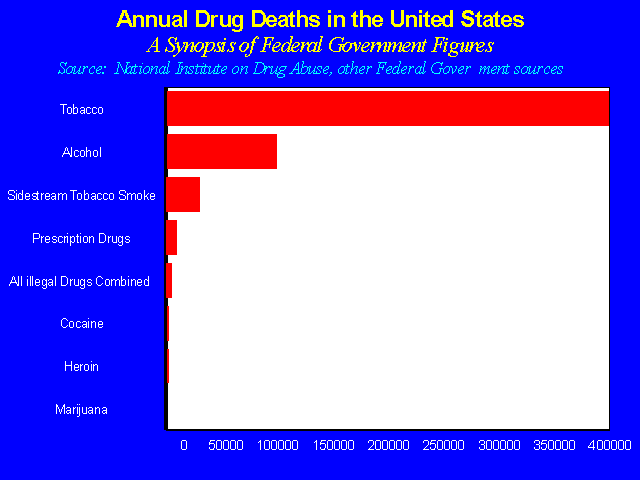FutureDevilDog
Active member
The number of drug deaths in the US in a typical year is as follows:
- Tobacco kills about 390,000.
- Alcohol kills about 80,000.
- Sidestream smoke from tobacco kills about 50,000.
- Cocaine kills about 2,200.
- Heroin kills about 2,000.
- Aspirin kills about 2,000.
- Marijuana kills 0. There has never been a recorded death due to marijuana at any time in US history.
- All illegal drugs combined kill about 4,500 people per year, or about one percent of the number killed by alcohol and tobacco. Tobacco kills more people each year than all of the people killed by all of the illegal drugs in the last century.

Which drug causes the greatest burden on our medical facilities?
Alcohol and tobacco are the clear leaders. Some authorities have estimated that up to forty percent of all hospital care in the United States is for conditions related to alcohol.
As a medical hazard, few drugs can compete with alcohol or tobacco on any scale. A study at Rockefeller University in 1967 concluded that "Tobacco is unquestionably more hazardous to the health than heroin."
Do illegal drugs have any legitimate uses?
Heroin is a powerful pain-killer and could be used to control extreme chronic pain or the pain of severe diseases, such as cancer. The medical literature shows that heroin is significantly less hazardous than most of the drugs which are given in its place.
Cocaine is used as a topical anesthetic in medicine.
There are about 50,000 products which can be made from the marijuana (hemp) plant. It has been used since the dawn of history for the widest variety of uses. These uses include fibers, fuels, materials, and medicine.
The first American laws regarding marijuana were passed in the 1700's and required farmers to grow hemp (marijuana) because of its tremendous commercial value for dozens of uses. It was grown throughout the United States as a commercial product well into the 1940's. It was made illegal in 1937 largely as a result of pressure from oil and chemical companies who feared the competition from marijuana. Despite the laws, during World War II marijuana was considered so vital to the national interest that the US Government exempted farmers from military duty if they grew marijuana. Local 4-H clubs were encouraged to have their members grow marijuana and the US Government produced a film called "Hemp for Victory"'
Marijuana produces fibers which are ideal for ropes, cloth, paper, and dozens of other products. The fiber is unusually strong, soft, absorbent and cheap to produce. If we grew marijuana solely for paper production, we could completely eliminate cutting forests for paper. Marijuana produces eighty times as much usable fiber per acre as a comparable stand of forest.
Marijuana can produce several different kinds of fuel. In the 1800's and 1900's hempseed oil was the primary source of fuel in the United States and was commonly used for lamps and other oil energy needs. The diesel engine was originally designed to run on marijuana oil because Rudolf Diesel assumed that it would be the most common fuel. Mairjuana is also the most efficient plant for the production of methanol. It is estimated that, in one form or another, marijuana grown in the United States could provide up to ninety percent of the nation's entire energy needs.
Marijuana is useful for a wide variety of medical problems and, according the the Drug Enforcement Administration's Chief Administrative Law Judge, "marijuana is probably the safest therapeutically active substance known to man," and "it is safer than many of the foods we commonly eat." Marijuana is often the most effective treatment for chronic pain, glaucoma, nausea from chemotherapy, multiple sclerosis, epilepsy, and other medical conditions.
Which drugs are the most addictive?
This is a difficult question to answer because it depends upon a lot of factors in both the drug and the person who uses it. In an attempt to define clearly what is meant by addiction, and which drugs are the most addictive, Dr. Jack E. Henningfield of the National Institute on Drug Abuse and Dr. Neal L. Benowitz of the University of California at San Francisco ranked six psychoactive substances on five criteria.
- Withdrawal -- The severity of withdrawal symptoms produced by stopping the use of the drug.
- Reinforcement -- The drug's tendency to induce users to take it again and again.
- Tolerance -- The user's need to have ever-increasing doses to get the same effect.
- Dependence -- The difficulty in quitting, or staying off the drug, the number of users who eventually become dependent
- Intoxication -- The degree of intoxication produced by the drug in typical use.
The rating scale is from 1 to 6. 1 denotes the drug with the strongest addictive tendencies, while 6 denotes the drug with the least addictive tendencies
Tables: http://www.druglibrary.org/schaffer/library/basicfax.htm#q5
Can we win the war on drugs?
We could win the war on drugs if we could be successful in at least one of three areas:
http://www.druglibrary.org/schaffer/library/basicfax.htm#q7
Read the rest here: http://www.druglibrary.org/schaffer/library/basicfax.htm#q1
Then God said, "I give you every seed-bearing plant on the face of the whole earth and every tree that has fruit with seed in it. They will be yours for food."
The Bible
Genesis 1:29
Last edited:
